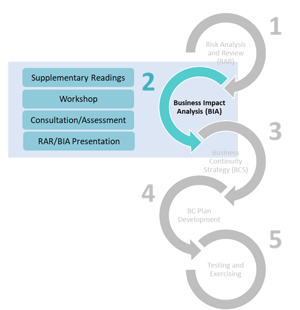Overview of BCM-310 (Session 2)
Business Impact Analysis
You are about to attend the second (session or 1/2 day) of the one-day BCM-310 workshop. The course code is BCM-310. This course consists of the following:
 The "Risk Analysis and Review" or RAR phase is attended as Module 1 Session 1, the first half-day onsite, and is conducted in the morning or the previous half-day online session.
The "Risk Analysis and Review" or RAR phase is attended as Module 1 Session 1, the first half-day onsite, and is conducted in the morning or the previous half-day online session.- The "Business Impact Analysis" or BIA phase is attended as Module 1 Session 2 or, usually, on the same day in the afternoon.
Ignore Project Management Part 1A and 1B if you already have a BCM framework and policy.
| Again, it may be helpful if you have not read the first two articles regarding how this project started; you may want to read "[1A] Starting the Project" and "[1B] Developing BCM Structure and Framework." Click the icon on the right side. |  |
| If you are attending as a business unit BCM coordinator, be mindful that your project team has spent two modules or a 2-day BCM-410 course to set up the requirement for you to complete your unit submission with minimum effort. | ![[ITL] [1B] [PM] BCM Training-led Implementation: Developing BCM Structure and Framework](https://no-cache.hubspot.com/cta/default/3893111/304ac1bb-a4a1-426b-9724-838c7052807a.png) |
This article is the second of the six-part "Training Led BCM Implementation Project" series. This is the reading for participants embarking on a BCM implementation using a combination of training guided by experienced BCM professionals to develop, implement and finalize its BCM program for an organisation.
Business impact analysis, or BIA, is analysing the effects of interruptions on business functions and the organisation as a whole. Based on the severity of these effects, the BCM Planner could infer the relative recovery priorities of these business functions.

The process of conducting the "Business Impact Analysis" or "BIA" in the Training-led BCM Implementation is as follows:
 1. Supplementary Readings
1. Supplementary Readings
- Participants will receive emails containing bite-size information on business impact analysis.
- Doing so aims to introduce them to the fundamental BIA concepts ahead of the workshop.
- This helps participants optimize their time at the workshop.
What participants should do:
2. Facilitated Workshop

 A workshop is conducted to guide business unit BCM coordinators (click left icon) to collect data on:
A workshop is conducted to guide business unit BCM coordinators (click left icon) to collect data on:
- Critical business functions (CBFs),
- Potential impacts of a prolonged disruption of CBFs
- The time periods within which the CBFs must be recovered to minimize losses
- The key dependencies to perform CBFs
- Resources necessary to perform CBFs
Templates are used to facilitate the BIA data collection process.
What participants should do "Before" the workshop:
The BIA is an essential cornerstone of the business continuity planning process. Participants are encouraged to read the supplementary email materials before the workshop.
Participants should:
- Read through the supplementary pre-readings
- Complete the e-learning module "Business Impact Analysis."
- Download the BIA templates onto their laptops
- Start to complete the BIA template with the help of the guidance note
- Write down any questions they may have or any answer that you could not complete for this template
It is important to note that because the workshop is a 1-time group event, it is vital that participants lock this event in their calendars. No repeat workshop will be conducted for absent participants.
What participants should do "After" the workshop:
After the workshop, participants will have two working days to complete and submit the BIA templates via the eCampus portal to the BCM workshop facilitator. Once BCM Institute's facilitator conducts the first review, you, as a participant, can make the necessary changes and submit them to your organisation's BCM Coordinator and Version 2.0, who will consolidate the templates.
- Submit the BIA templates via the eCampus submission portal on time
- Once the workshop facilitator reviews your submission, proceed to review your templates based on the comments provided
- Submit your revised completed template to your Organisation BCM Coordinator via eCampus as Version 2.0.
Value-Adding Service
Access to the eLearning module is subject to BCM Institute's agreement with the in-house organization:
3. Consultation with Project Team Leader [Online]
The Organisation BCM Coordinator will process the templates from all departments and write a report for submission to management.
 Optional: A complimentary one-hour consultation session has been arranged for the Organisation's BCM Coordinator to review the report with the workshop facilitator. This session is subject to the initial conditions and class size as agreed upon at the start of the project.
Optional: A complimentary one-hour consultation session has been arranged for the Organisation's BCM Coordinator to review the report with the workshop facilitator. This session is subject to the initial conditions and class size as agreed upon at the start of the project.
4. RAR & BIA Presentation (Optional)
At this juncture, updating senior management on the project's progress is appropriate.
The Organisation BCM coordinator (OBC) (click the left icon) will present the consolidated interim findings of the RAR and BIA to management or the BCM Steering Committee. Once the results are endorsed, the reports are finalized and submitted.
What senior management should do:
- Review the key risks for the organization (RAR)
- Review the list of critical business functions and their recovery time objectives (BIA)
- Endorse the findings.
Henceforth, during the subsequent two phases, the developed Business Continuity Strategy (BCS) and Plan Development (PD) phases will be based on these endorsed findings.
We will enter into the BCS phase of the project only after management endorses the RAR and BIA findings.
5. Next Step
![TMM [WSQ BCM-320]](https://no-cache.hubspot.com/cta/default/3893111/deace48e-f01d-4530-a35b-0975e7985908.png) Once this session is completed, you are ready to attend the 2nd one-day or two 1/2-day sessions of the WSQ course, "Developing Business Continuity Strategies and Plans." The course code is BCM-320. Read more about the expectation for the next 1/2-day workshop, "Evaluating the Business Continuity Strategy".
Once this session is completed, you are ready to attend the 2nd one-day or two 1/2-day sessions of the WSQ course, "Developing Business Continuity Strategies and Plans." The course code is BCM-320. Read more about the expectation for the next 1/2-day workshop, "Evaluating the Business Continuity Strategy".
4. Public BCM-310-320-330 Course
One of the challenges to maintaining the competency of this program is training newly appointed business unit BCM coordinators when they replace the incumbent. The newly appointed officer can undergo the same activity, and he/she is allowed to bring his/her current templates to the public course offered by BCM Institute. Just make the advanced arrangement with the BCM Institute's program admin team.
If you are attending a public BCM-310-320-330 competency-based course, it is similar to the afternoon session for the BCM-310 (Course code) and is titled "Assessing Risk and Business Impact Requirements."
Training-led BCM Implementation Roadmap


![[BCM] [EL] [L4] Business Impact Analysis](https://no-cache.hubspot.com/cta/default/3893111/8b84fc45-870b-4f09-b912-3fe1304238f1.png)
.jpeg?width=257&name=Senior%20Management%20Briefing%20(2).jpeg)

![TMM [WSQ BCM-310]](https://no-cache.hubspot.com/cta/default/3893111/b444171e-f81d-41c5-bc2a-c5728c5ef271.png)
![[ITL] [2] [RAR] Training-led BCM Implementation: Running the Risk Assessment](https://no-cache.hubspot.com/cta/default/3893111/667b23cb-0ff8-4d09-ae4e-0b54f000e353.png)
![[ITL] [4] [BCS] Training-led BCM Implementation: Evaluating the Business Continuity Strategy](https://no-cache.hubspot.com/cta/default/3893111/fed0fded-5b6a-42da-95b6-2788b0597ab1.png)
![[ITL] [6] [TE] Training-led BCM Implementation: Executing Tests and Exercises](https://no-cache.hubspot.com/cta/default/3893111/8971336e-4d4d-4ef5-b274-96b552356db5.png)
![[ITL] [3] [BIA] Training-led BCM Implementation: Executing the Business Impact Analysis](https://no-cache.hubspot.com/cta/default/3893111/d00710d6-0650-45b7-97aa-7ccde268d7b9.png)









